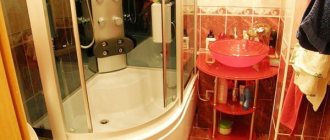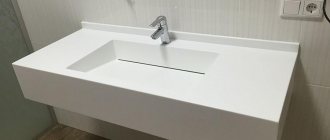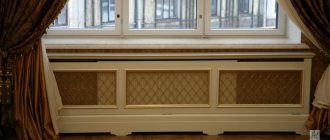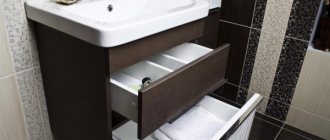I’ll immediately answer the question: is it possible to install a heating radiator instead of a heated towel rail? The answer here is clear - yes, it is possible. Such a replacement is quite affordable and depends only on the wishes of the owner. In this situation, I consider another question more logical: “Why and how is this done?” You will get answers to this in this article.
Source art-liga.rf
Heating appliances in the bathroom
The heated towel rail performs the function of heating the bathroom.
There is no doubt that a battery is needed in the bathroom, but why is it there? We are talking about an ordinary radiator that is in every room. In the bathroom, the heated towel rail is mainly used as a heating device. This is, in fact, a water heating register, whose main function is heating. This means that he is also a kind of battery.
The bathroom is small, so a towel is usually enough. In large bathrooms, the power of a heated towel rail will not be enough; in this case, it is necessary to install a battery in the bathroom. Suitable for this:
- Steel batteries;
- aluminum radiators;
- bimetallic radiators.
The latter are the most practical and reliable. But it also happens that you inherited a cast-iron radiator in the bathroom along with the apartment. Previously, they weren’t particularly worried about making it beautiful. The main thing is quality and durability, so we installed ordinary cast iron radiators in three sections in the bathroom. Usually they are replaced with either a water heated towel rail or a combined unit (battery + heated towel rail). Here you need to look at the heat loss of the room.
Fountains and saucers in the corners
And yet, you can’t do without humidifying the air: even the best batteries will still dry it out.
There are many ways to do this, and you can often do without special equipment. Thus, indoor plants purify and humidify the air. But don’t think that a small violet can seriously increase the humidity in a large room. These should be large plants with large leaves, and there should be several of them in a large room. Aquariums with fish and indoor fountains and waterfalls can humidify the air. You can also place containers of water in the corners of the rooms. Saucers are best suited for this: from them, water evaporates faster, humidifying the air.
Photo: Shutterstock.com
Do you need a heating radiator for your bathroom?
It would seem that the question is rhetorical, of course, necessary. Nowadays, when every second citizen has a higher education, there is no need to explain that the bathroom is classified as a room with a high level of humidity. Therefore, you need a heating device that can not only function flawlessly in such conditions, but is also capable of creating comfortable conditions in the bathroom.
We will still remind you of the tasks that a heating radiator in a bathroom successfully copes with:
- Heating the room.
- Speeding up the drying process.
- Preventing mold and mildew.
- Comfortable microclimate when carrying out hygiene procedures in the cold season.
In standard bathrooms, in addition to a heated towel rail, three or four additional sections of heating radiators are usually installed. This applies to almost the entire territory of Russia, except, of course, the southern regions, where winters are quite mild.
If the bathroom is insulated and equipped with a heated floor system, then installing a radiator in the bathroom may not be necessary. In the case of low floor heating power or its complete absence, it makes sense to install not only radiators, but also a heated towel rail. The latter is usually connected to hot water pipes (if there is one), or another option is an electric “towel”. In general, there are a lot of modifications, the decision is yours, and we will consider the question of the need for heating closed.
Universal insertion method
The coil operates on the principle of a gravity pump. If you insert it correctly, natural circulation and proper operation of the radiator are guaranteed. It is necessary to develop an installation diagram, strictly following the model instructions, and also taking into account the location of the riser in the bathroom.
For most models, the best option for tapping is to supply the coolant through the upper outlets (and the outlet is made from below). This is achieved using universal connections for the battery in the bathroom (photos of examples of work are in our article). This type of insert has a number of advantages:
- the direction and speed of water supply in the riser do not in any way affect the performance of the battery;
- there is no need to bleed air after circulation is turned off.
Another important advantage is the independence of the installation from the location of the riser.
Requirements for bathroom heaters
To ensure that the bathroom always has a comfortable temperature, it is necessary to select equipment that meets certain comfort requirements:
- Each heater must be adapted to operate in wet conditions. This suggests that it is necessary to choose a device that is protected from splashes. It is also necessary to ensure that the heater is covered with an anti-corrosion layer, otherwise it will not be possible to avoid the appearance of rust, which will spoil the appearance of the equipment, and over time, completely render it inoperable.
- Equipment located in the bathroom should take up little space, since usually this room is not the largest in size in the house. Each area in the bathroom has a specific purpose, and it will be extremely inconvenient to purchase a large heating device that fills the entire space.
- The equipment must have the necessary power to heat a particular room.
- The power of the device must be safe for rooms and people who will often be in the bathroom. This is especially true for children
- A heater located in a bathroom should look aesthetically pleasing and beautiful. It is advisable to select equipment that ideally matches the style of the already created interior, so that the overall background of the room does not deteriorate. In most cases, people buy devices in white or blue.
The bathroom heater must be adapted to work in humid conditions
Warranty, prices
Prices for radiators depend on their size and power, the material from which they are made, and the finish. A regular one costs from 4,900 rubles, an electric one - from 3,700 rubles.
You will pay about 3,300 rubles for a separate electric radiator. Warranties for electric dryers and heaters range from one to 2 years, although longer periods of up to 8 years are available.
Types of heating devices for the bathroom, their capabilities
There are many types of heaters for the toilet and bathroom:
- water heating radiator;
- electric convector;
- infrared heater;
- heat fan;
- panel heater;
- oil radiator.
The choice of heater model depends on the size of the bathroom and technical capabilities
Heating batteries
Coils and wall radiators for heating
This includes both heated towel rails and conventional heating radiators, which are found in kitchens, living rooms and bedrooms. There are many options to choose from:
- A water-based heated towel rail is a good solution for small forms. But using it to heat a large-format bathroom will be quite difficult;
- Electric heated towel rail - convenient, beautiful, expensive. Such a device requires large financial costs or can be combined with other types of heating: a water coil, a radiator, or a “warm floor” system. True, it all depends on the area of the room;
- Aluminum radiators are lightweight structures that provide greater heat transfer. When connecting the battery to a hot water riser, be sure to weld the gas outlet pipes: aluminum releases a certain amount of gas when in contact with boiling water.
Advice! The battery joints must be soldered! This is the only way to ensure tightness when pressure increases in the pipes and resist corrosion. In addition, soldering looks more aesthetically pleasing than any other type of connection.
- The cast iron battery is a budget option. Resistance to damage, durability and long service life are clear advantages of the radiator. But low heat transfer and heavy weight are not always good for the bathroom.
- A steel battery is a fairly practical heating element. High heat transfer, ease of installation, increased thermal inertia - all these are the advantages of this radiator. Some problems can only be caused by the sensitivity of the metal to draining water.
- Bimetallic structures are expensive, but very practical bathroom heating. This is the best option that combines all the pros and has no cons.
Advice! When choosing a chrome-plated steel version of the battery, remember that such a heater has a reduced heat transfer (by almost 35%), so it is better to select a radiator of greater power and size. And the chrome surface does not tolerate water vapor from household chemicals well (stains remain).
Heating materials
We will not start a debate here about the effectiveness of this or that radiator material, or provide formulas and calculations of heat capacity and heat transfer. This topic requires a separate article, and if you describe the calculation and production of heating batteries with your own hands, then several.
We recommend: Heating equipment for the home
In the end, in the end, it is not the material that is put into the heating system, but a specific product with well-known characteristics. Parameters of almost any model can be found in manufacturers’ catalogs and tables.
Nevertheless, let’s get acquainted with the main types of heating devices:
- Cast iron - it is believed that such batteries are durable and have good heat dissipation. But, if you look at it, having the largest dimensions among all heating devices, they provide the least heat transfer. For vintage lovers, this is just the thing.
- Steel ones are not a very good choice of heating device for the bathroom. A humid environment causes pockets of corrosion on the body of the sections; over time, these areas can leak. Based on their design, housings are divided into panel and tubular.
- Aluminum - have a good design and low weight. According to many experts, such batteries are an ideal choice for a bathroom in a house with individual heating. Owners of apartments with a centralized heating system should pay attention to reinforced models that can withstand significant water hammer and the influence of low-quality coolant.
- Bimetallic - structurally, the devices consist of a steel frame with an aluminum casing. They are assembled taking into account the characteristics of central heating networks. Average service life is 20-25 years. It happens that bimetallic radiators do not heat well due to installation errors, but this can be easily fixed.
- Copper ones have not yet been widely used in our country due to special installation and operating conditions. The cost of such devices is quite high, although they have plenty of advantages. There are also some restrictions, for example, manufacturers do not recommend installing copper batteries in networks that contain high amounts of chlorine salts.
When choosing heating devices for the bathroom, consider not only the characteristics, but also the design in order to fit them as harmoniously into the overall interior as possible. In general, judging by the manufacturers' data, the heat transfer of batteries made of any materials except cast iron is almost the same, the difference is literally within 5%.
With cast iron equipment, things look different. If we bring the depth of a section of a bimetallic or aluminum radiator (80-100 mm) to the depth of a cast iron one (140 mm), then the heat transfer of the latter will be ⅓ lower.
From all of the above, the conclusion suggests itself: the material does not have a significant effect on the thermal efficiency of the device, with the exception of cast iron. Therefore, when buying a heat exchanger, it is better to look at its cost, dimensions, and quality. And finally, don’t lose sight of its appearance, so that you don’t have to worry about how to cover the radiator in your bathroom.
Infrared heaters: efficient heat
The difference between an infrared device and others is that it is mounted on the ceiling, but it warms not the air, but the floor and walls of the room. The product consists of a quartz emitter - a special plate that emits heat, heating up to 260 degrees. Such a heater takes up practically no space; when heated to a certain limit, it turns off on its own.
When choosing an infrared panel heater, you need to make sure that the model is designed for rooms with high humidity
The most interesting feature of the device is that the direction of the rays can be easily adjusted, heating the desired place, which is especially convenient in spacious rooms and allows you to use electricity economically. A high level of humidity is not harmful to the product, and the high cost will be compensated by the benefits received from use.
Electric convector
In this heater, as in many others, the heating element is made of a powder composition with a thin heating filament made of nichrome. The housing is made of silumin, the design itself is modular (allows you to change the power level and dimensions of the device), wall-mounted.
Operating principle of a convector heater
The temperature is controlled using a thermostat, the internal heating level is 350 degrees, the housing is 55. The product is highly electrically safe and is suitable for heating wet rooms.
Wall-mounted models of electric convectors are designed for the bathroom
A variety of similar heaters are also produced that operate without infrared radiation - completely silent, outwardly resembling a fragment of horizontal blinds.
Fan heater
A simple and convenient bathroom fan heater, extremely affordable, quickly warms small spaces. The power of the device is 2000-2500 W, the dimensions are minimal, the shape is different. The design consists of a fan in a plastic casing with a spiral heating up to 800 degrees. Heat is distributed throughout the room by a fan, quickly warming up the room.
Fan heaters are available in various capacities and sizes, including built-in models.
Fan heaters for any bathroom area are very compact, light in weight, and easy to install on the floor, wall, furniture surfaces and window sills. The main advantages are light weight and size, beautiful appearance, ease of operation. Disadvantages - the operation process is noisy; if it is poorly maintained (if a lot of dust has accumulated on the device), it has an unpleasant odor.
Oil radiator
Models of oil radiators for the bathroom
A simple, familiar and ordinary heater that is found in almost every home. You can create heating in the bathroom using a radiator if you choose the right power. The design has the following advantages:
- Safety - even if a newspaper falls on the radiator, nothing bad will happen; the absence of open heating elements allows such missteps;
- Mobility - the light weight and shape of the device are good when you need to move the radiator to another room or remove it altogether;
- Does not burn oxygen - this is a very important fact, especially for small bathrooms.
Important! Many radiators are equipped with temperature controllers, programmable timers and LCD indicators. All these additions are necessary if you want to set the program and keep your bathroom warm without unnecessary hassle for a long time.
Liquid heated towel rails
Since any bathroom needs a heated towel rail, it is necessary to choose this item wisely. The traditional type of liquid heated towel rail is a curved pipe that connects to the home's water system. Thus, you can get a heating device that not only warms up damp things, but also maintains the optimal temperature in the room.
We recommend: How to make air heating of a private house with your own hands - diagrams, photos and videos
The heat transfer from the dryer is not too great, and therefore the design does not include radiating surfaces or ribs that form upward heat flows.
A heated towel rail is an ordinary curved pipe, the diameter of which is comparable to that of a water pipe. The device can also be a ladder consisting of a certain number of elements. Hot water will flow inside the pipe, with the help of which a towel or things can be dried in a fairly short time, while creating a comfortable temperature inside the bathroom.
Liquid heated towel rails for heating the bathroom
From this we can conclude that the equipment is very useful in winter, but it is worth noting that when cold water flows through the pipes, the heated towel rail becomes useless - no heat will be received. You also need to know that such devices often become corroded. The fact is that tap water contains oxygen, and because of it, this process accelerates. When the hot water supply is turned off, the cold pipe will become covered with condensation, which can soon cause corrosion build-up.
Cable heated towel rails
A cable heated towel rail is equipment with a built-in cable, which resembles the one found in a heated floor system. But unlike the “floor”, electricity consumption is noticeably lower.
The cable version has a more original design than other types of bathroom heaters. This type of equipment is cheap because there is no need for increased tightness compared to the liquid model.
The cable type is also very easy to place at the workplace, since there is no need to connect heating elements to it, which are usually located at the bottom of the case. This suggests that the equipment is located in both a diagonal and vertical plane. The heated towel rail heats up very quickly, but at the same time it cools down quickly after switching off - this is a minus.
Warm floor - thoroughly and for a long time
For those who do not like half measures, there is another option for heating the bathroom - heated floors. It is advisable to ensure that the heated floors in the bathroom work autonomously and are not dependent on neighboring rooms, since the bathroom needs year-round heating, while in other rooms it is needed only in the cold season.
Engineering provides services for the development, management, and consulting of engineering and technical projects. In particular, the development of design documents for the construction of gas boiler houses and mini-CHPs with a feasibility study for construction and other design and construction documents. The design of gas boiler houses - TsMIP SGUU is carried out by high-level designers with extensive experience in carrying out various works and calculations that meet all modern requirements for projects of this type.
Video
Bathroom heaters will help create a warm atmosphere while bathing or doing laundry.
A heated, heated room is always more comfortable for families, especially with small children. Portable and stationary heaters can be used both in the nursery and in other areas of the house. The market is replete with numerous models that differ in power, cost and method of operation. Depending on the area of the room, the interior and the financial situation of the family, you can purchase and install a suitable device. You just have to make a choice based on the recommendations.
Source
Classification of heated towel rails
Dryers are divided into different groups according to type, size, installation method and material.
By type of coolant connection
The type of connection also determines three types of heated towel rails, and the type of connection plays one of the key roles when choosing a specific model.
- Water heated towel rail. Connects to the hot heating system. Heating occurs during the passage of a heated working environment. It is important to choose a model made of material that is resistant to aggressive water. During operation, there may be a risk of destruction of the structure of the internal walls, so the level of rigidity is an important factor when choosing . Made from stainless steel with a chrome finish , this is an excellent option that will last for many years.
- Electric heated towel rail. Does not depend on central heating . Requires an outlet at the installation site. Allows you to use yourself when necessary. There is a function for self-regulation of temperature data. Characterized by increased energy consumption.
- Combined heated towel rail. The most practical scheme for installation at home. You choose the connection type that is convenient for you. Alternating the heating method is optimal in different seasons of the year. So, you save money on utility bills. The cost of this modification is an order of magnitude more expensive than the above analogues.
Divided by size format
This variety is more of a design definition than an actual characteristic; it all depends, trivially, on the ratio of height and width.
- Horizontal heated towel rail. Combines the features of a dryer and radiator for heating. Installed as a window sill option. Will fit into any design. Does not take up a large area during installation.
- Vertical heated towel rail. It takes up an order of magnitude more space to be placed on the wall. Provides a large usable drying area. Available in exclusive shapes that will make your home decor stand out.
Type
There are 3 types:
- Mermen. Powered by hot water. The advantages include durability, strength, no additional maintenance costs, and low cost. There are no maintenance requirements; replacement is required primarily not due to breakdown, but for aesthetic reasons. The disadvantage is the dependence on hot water supply or heating (to which the dryer is connected). Some devices only work in winter, when the apartment is heated. Others become cold when there is no movement of hot water through the pipes.
- Electric ones are connected to the network for continuous operation. Their disadvantage is expensive maintenance. They are easier to install than water ones, because you don’t need to drill the walls, connect to the water supply, or use additional fittings.
- Combined ones combine the characteristics of both types. These heated towel rails are connected to both a hot water source and an electrical outlet. The ability to change modes allows you to always maintain a comfortable room temperature.
We recommend: Copper pipes for heating: price, features, advantages and disadvantages, popular manufacturers
By material
Dryers are made from different materials:
- Stainless steel will withstand high pressure. The walls of the pipe must be at least 3 mm thick.
- Steel is a cheap material. Dryers made from it are no longer sold, but most old houses have them installed.
- Copper is resistant to corrosion and conducts heat well. Such a product will not be heavy and looks good in appearance. Check that the pipe is galvanized on the inside for greater protection against water. The disadvantage of this option is the expensive price.
- Brass has the same “advantages” as copper. Products made from it are cheaper. The "disadvantage" is fragility. You should only buy dryers with chrome-plated inner walls.
Other non-ferrous metals and alloys (for example bronze) can also be used. Such products are rarely used due to their high cost.
Non-ferrous metals are often used to create designer dryers of non-standard shapes and colors.
What kind of pipes will we connect?
If for a private house, where the coolant temperature rarely exceeds 70-80℃, the use of polypropylene pipes is still acceptable, then in apartments not everything is so simple. In most cases, SNiP prohibits the use of not only polypropylene products, but also metal-plastic and cross-linked polyethylene in central heating systems. In emergency situations, the temperature of the network water can reach 120℃; a polypropylene pipe in such conditions will last for a couple of hours.
Even during normal operation, the temperature of the coolant in the central heating lines can be increased to 105℃ for a short time. The same propylene, when operated above 70℃, begins to rapidly lose its properties. We can talk about this topic for a long time, so based on the experience of using various pipes in apartment buildings, let’s summarize the results:
- In houses where there are no individual heating points, pipes made of steel, copper or stainless steel must be used to install heating radiators.
- In high-rise buildings with their own low-temperature heating system, it is possible to use any type of pipeline - polypropylene, metal-plastic, steel, copper and cross-linked polyethylene.
Important! Be that as it may, in central heating conditions, where safety requirements are high, you need to use pipes from trusted manufacturers with a long operating history. Beware of new product models that do not yet have a baggage of positive reviews.
Choosing a water heated towel rail
Choosing the right heated towel rail is a whole science, and especially a water one. The most important thing here is the shape, size and even the location of the bends, and there are also technical characteristics that also need to be taken into account.
Modern heated towel rail
Specifications
The operating pressure in the DHW system should be in the range from 0.3 atm to 6 atm. The pressure in the centralized heating system greatly depends on the area, but is rarely higher than 10–12 atm (in high-rise buildings). Select water dryers according to these parameters.
Before choosing a heated towel rail, pay attention to such an indicator as the maximum temperature. For hot water supply, this figure is rarely higher than 60 °C; for heating, few people give 80 °C. From this point of view, all stainless steel dryers are suitable, they have a maximum temperature of about 105–110 °C. Nevertheless, emergency situations occur when water is supplied heated to a hundred degrees or even higher, so this reserve will not hurt.
Deciding on the form
Water towel dryers come in different shapes. They can be divided into several groups:
- U or U shaped. The simplest in form and having the lowest cost. The disadvantages include their small “usable” area, as well as the not very large amount of heat that they can generate. You can't hang a lot of things on them. But such a towel dryer in the bathroom, with the correct size selection, can “stand” in the place of an old similar shape without modification.
- Snake, coil or M-shaped. A slightly more complex shape, more usable area and heat generated. They are also not very difficult to connect and have a low price. Snake dryer. Maybe not a masterpiece, but it lasts a long time
- Ladder. A heated towel rail consisting of a number of horizontal bars united at the edges by vertical collectors. The crossbars can be straight or in the form of a snake. Such a device usually has two connection methods - side and bottom. A more complex form requires a well-chosen scheme, otherwise it will not work. In addition, due to the high material consumption, the cost of such dryers is several times higher than coils.
- Non-standard complex shapes. There are unusual towel rails that look more like designer decorations than plumbing fixtures. Their prices are not low, and most of them are delivered “to order”. Problems often arise with their connection, so you need to choose the right circuit and consult a specialist.
Choosing a bathroom dryer according to its shape is both simple and difficult. You need to consider how and where you can install the design you like. At the same time, do not forget that you will have to connect it to a riser, which means pulling pipes along the walls to it. Moreover, most likely, the gasket will be hidden, that is, it will be hidden in the wall, which means that it will be necessary to ditch them or install a false wall.
Connection and installation features
An electric heated towel rail is connected to a regular socket, but since the installation location is a bathroom with high humidity, the voltage must be supplied through an RCD that breaks phase and zero; an automatic circuit breaker is also needed, perhaps one contact. The choice of their electrical parameters depends on what other devices will be connected to this line. It is not worth running a separate line to the heater due to its low power.
Thermostats have different shapes, but the functionality is usually the same
The heated towel rail can be installed anywhere. Usually the protection class allows it to be installed even above a bathtub (II), but this is hardly worth doing. It’s inconvenient, and things will get wet. It is usually best to install an electric dryer on any free wall. Often so that you can reach from the bathtub or shower stall. If the bathroom is combined, you will have to choose. You can also place it not far from the bidet or toilet with a hygienic shower. By the way, mounting brackets are usually included in the kit, so you don’t have to invent anything.
Advantages and features of the bottom connection
Similar unit installation schemes have been popular in recent years. Because by securing the heated towel rail from below, you can hide excess pipes with various accessories or interior items. In stores you can find a wide range of models that will be installed in this way. But despite its visual appeal, the bottom connection scheme is less effective than a direct or side connection. And for it to work, it is worth considering a number of points:
- For the installed unit to be effective, the bottom outlet of the riser must be below the edge of the heated towel rail.
- If the upper outlet of the riser with a narrowed or offset bypass is located below the unit, so that it works in any direction of water flow. Even when using straight pipes, a slight lift is required. A strictly horizontal position of the outlet is allowed only when using wide pipes and a short distance from the riser.
- Vertical pipe sections can be of any length. This will allow them to be embedded as close to the floor as possible, regardless of the height of the heated towel rail. Efficiency will not be lost regardless of the direction of water movement in the riser.
- Bends with this connection are also unacceptable, since they provide a place for the formation of air pockets.
- However, if a bottom connection is planned, and the pipe insertion points are so high that the device will be too high to meet all connection conditions, one of the connections can be placed above the bottom edge of the heated towel rail, observing two main conditions. Firstly, the direction of water flow in the riser must be strictly downward. And the upper outlet must be below the edge of the device. Otherwise the system will not work.
- The presence of a thermal insulation layer is mandatory, since they usually try to hide all drainage elements.
In view of the existing conditions, it is worth paying attention to popular heated towel rail connection diagrams. Some of them may be deliberately inoperative due to non-compliance with standards
Therefore, if the master offers you options with inlet bends, a narrowed or offset bypass, be careful. This way you will avoid disappointment when, even if the hot water supply is working properly, the heated towel rail remains cold.
Let's summarize: install or can, not the name of special skills. The easiest option to connect may be a device powered by electrical energy. If you choose a device that operates via a heating system or hot water supply, consider some details. First, find out how often the heating or hot water is turned off in your area. This will determine the time when the heated towel rail is useless. This does not apply to persons living in houses in which water is heated by a water heater or boiler.
Since there are several main options for connecting a heated towel rail to a riser: direct, side, diagonal or bottom, the choice should be made based on the initial position of the device and its height. The easiest to implement is a direct connection.
Several conditions are worth considering when choosing a side or bottom method, especially if an offset bypass or narrowed pipes are used. When choosing one of the latter methods, analyze and refuse options that will obviously not work. And then your heated towel rail will be a beautiful and functional piece of furniture.
Equipment selection rules
When choosing heating radiators, preference is given to devices that can heat the room and dry clothes. At the same time, it is desirable that they fit well into the interior of the bathroom. According to the design features and bending shape of the pipes, standard products are divided into two types, one of which resembles the letter “P”, and the other - “M”. The choice of one option or another depends on the user's preferences.
The industry also produces more modern designs, distinguished by the originality of their forms. Such heaters are made in the form of a zigzag or resemble a run of stairs in shape.
It is recommended to purchase a device in which the number of drying places corresponds to the number of users living in the house.
There are examples of drying units with expanded functionality - they include convenient shelves for toiletries.
History of creation
In 1867, Georges Leclanche invented the first variation of a chemical current source. The first battery was very different in appearance compared to its modern counterpart.
However, the idea of storing electricity was first introduced in the development of A. Volta; most people, when asked who invented the battery, name him. Everedy was the first to produce autonomous power supplies for miners. Later, people who went on long voyages began to use the device.
A big step in the development of DC batteries was made by Duracell, which produced cheap and compact types of power supply. A graphite rod embedded in manganese oxide was placed in a zinc glass. Until the mid-20th century, this type and operating principle of the battery remained unchanged.
The discovery was the invention of lithium batteries. They accumulated more energy than their predecessors. Over time, the sources have undergone a huge number of changes. There are many options for how a battery is designed.
Design
The most common among ceramic heaters are panel heaters. The case is metal with a polymer coating inside. For heating, heating elements, halogen, and carbon lamps are used. A heat-reflecting screen is installed between the rear wall of the housing and the heater. A ceramic plate is mounted on the front side.
When connected to the network, the heater heats up, heat is transferred to the ceramic surface, causing infrared radiation. Part of the thermal energy is dissipated in space by convection.
A ceramic stove works like a battery. It emits heat for 15-20 minutes after disconnecting the device from the network, heating the room.
Ceiling heater











